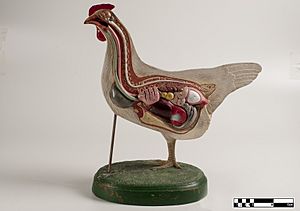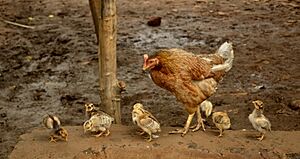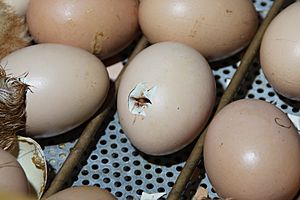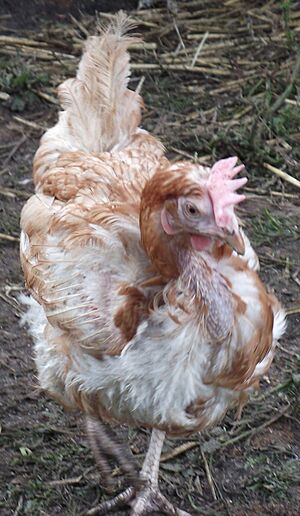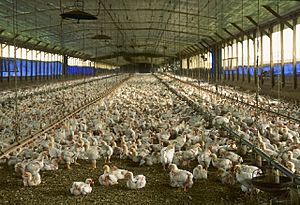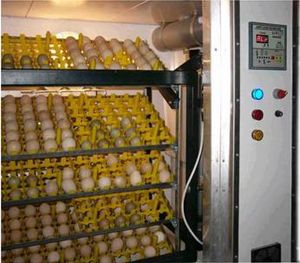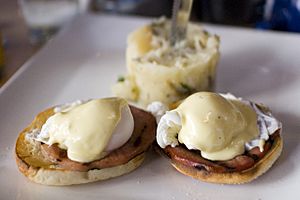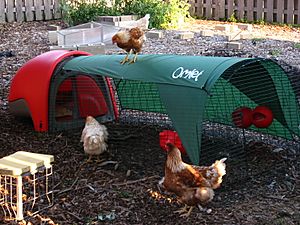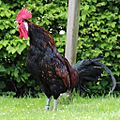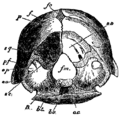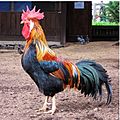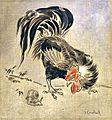Chicken facts for kids
Quick facts for kids Chicken |
|
|---|---|
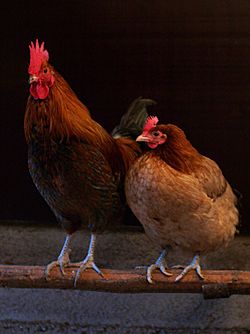 |
|
| A rooster (left) and hen (right) | |
| Conservation status | |
| Scientific classification | |
| Kingdom: | |
| Phylum: | |
| Class: | |
| Order: | |
| Family: | |
| Genus: | |
| Species: | |
A chicken (Gallus gallus domesticus) is a type of domesticated bird. People around the world raise chickens for their meat and eggs. There are about 24 billion chickens on Earth! Humans usually keep them as livestock, which means they are raised for food. Most chickens can fly short distances. Some even sleep in trees if they have them.
A male chicken is called a rooster or a cock. A female chicken is called a hen. A young chicken is called a chick. Like other female birds, hens lay eggs that can hatch into chicks.
When farmers raise chickens, they build a special house called a chicken coop for the chickens to sleep in. Chickens also need a yard where they can run, take dust baths, eat, and drink. Farmers protect their chickens from animals like foxes using fences.
Sometimes, chickens are raised in a way called intensive farming. This helps farms produce lots of meat and eggs. However, this way of farming is not always the best for the chickens.
Contents
About Chickens
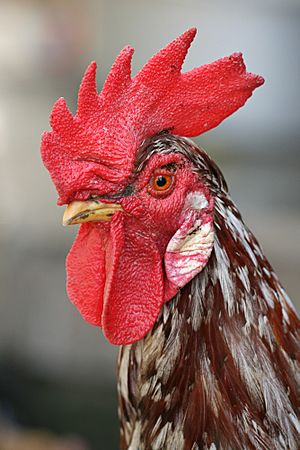
Chickens are omnivores, meaning they eat both plants and animals. In the wild, they often scratch the ground to find seeds, insects, and even small animals like lizards or young mice.
Chickens can live for five to ten years, depending on their type. The oldest chicken ever lived to be 16 years old!
Roosters often look different from hens. They have long, flowing tail feathers and shiny, pointed feathers on their necks and backs. These feathers are usually brighter and bolder than a hen's. But in some types, like the Sebright chicken, the rooster's feathers are similar to the hen's.
You can also tell them apart by looking at their comb (the fleshy crest on their head) and wattles (the skin flaps under their beak). Both males and females have combs and wattles, but they are usually bigger on roosters. Some chickens have extra feathers under their face, which looks like a beard.
Domestic chickens cannot fly long distances. Lighter chickens can fly over fences or into trees to roost. They might fly briefly to explore or to escape danger.
How Chickens Act
Living Together
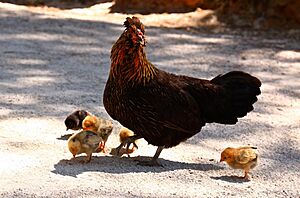
Chickens are social birds and live together in groups called flocks. They often work together to incubate eggs and raise their young. In a flock, chickens have a "pecking order". This means some chickens are more dominant and get to eat first or choose the best nesting spots. If chickens are removed from a flock, the pecking order changes until a new one is set. Adding new chickens, especially younger ones, can cause fights.
When a rooster finds food, he might call other chickens to eat first. He does this by clucking loudly and picking up and dropping the food. Mother hens do this too to call their chicks.
A rooster's crow is a loud, sharp call. It tells other roosters that this is his territory. Roosters also crow when something suddenly disturbs them. Hens cluck loudly after laying an egg and to call their chicks. Chickens also make a quiet "warning call" if they see a predator nearby.
Courtship and Mating
To start courting, some roosters do a "circle dance" around a hen. They often lower the wing closest to the hen. If the hen responds, the rooster may mate with her.
Laying Eggs
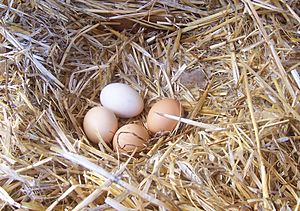
Hens often try to lay their eggs in nests that already have eggs. They might even move eggs from other nests into their own. Because of this, a flock will use only a few favorite nesting spots. Hens often prefer to lay in the same spot every time. Sometimes, two or more hens might try to share the same nest. If the nest is small, they might even try to lay on top of each other! Some farmers use fake eggs made of plastic or stone to encourage hens to lay in certain spots.
Broody Hens
In nature, most birds lay a full set of eggs, then sit on them to make them hatch. Many hens do this too, and we say they "go broody". A broody hen stops laying eggs. Instead, she focuses on keeping her eggs warm. A full set of eggs is usually about 12. She will sit on the nest, protesting if disturbed. She rarely leaves the nest to eat or drink. While brooding, the hen keeps the nest at a steady temperature and humidity. She also turns the eggs often.
Farmers can encourage broodiness by placing artificial eggs in the nest. To stop it, they might put the hen in a cage with an open wire floor.
Modern egg-laying chickens rarely go broody. But some older types of chickens, like the Cochin or Silkie, often go broody. They make great mothers, not just for chicken eggs, but also for eggs from other birds like quail or turkeys.
Hatching Chicks
Fertile chicken eggs hatch after about 21 days. The chick starts to grow only when the egg is kept warm. So, all chicks hatch within a day or two of each other, even if the eggs were laid over a couple of weeks. Before hatching, the hen can hear the chicks peeping inside the eggs. She will cluck softly to encourage them to break out.
The chick first makes a small breathing hole with its egg tooth. This is usually at the blunt end of the egg. The chick then rests for a few hours. It absorbs the rest of the egg yolk and pulls blood from the membrane under the shell. Then, the chick makes the hole bigger, turning as it goes. Finally, it breaks off the blunt end of the shell like a lid. The chick crawls out, and its wet down feathers dry in the warmth of the nest.
Hens usually stay on the nest for about two days after the first chick hatches. During this time, the new chicks get food from the yolk sac inside them. Hens protect their chicks fiercely. They keep them warm by sitting on them, especially at night. The hen leads her chicks to food and water. She calls them to edible items, but she rarely feeds them directly. She cares for them until they are several weeks old.
Where Chickens Come From
Domestic chickens mostly come from the red junglefowl (Gallus gallus). They are considered the same species and can breed with red junglefowl. Scientists have found that the gene for yellow skin in domestic chickens came from breeding with the grey junglefowl (G. sonneratii).
Studies show that chickens were found in the Americas, Europe, the Middle East, and Africa. They originally came from the Indian subcontinent.
Some believe chickens were first tamed in Southern China around 6000 BC. But newer studies question if those birds are the ancestors of today's chickens. Another idea is that they came from the Harappan culture in the Indus Valley. Chickens then spread to central Asia and reached Europe around 3000 BC.
In the Middle East, chickens appeared a little before 2000 BC in Syria.
It's still debated if chickens were in the Americas before Europeans arrived. But blue-egged chickens, found only in the Americas and Asia, suggest an Asian origin for early American chickens.
It's hard to map out exactly how chickens spread everywhere. This is because there isn't enough information from places like Thailand, Russia, and parts of Africa. Studying local chicken types that are in danger of extinction might help.
Chickens in South America
An interesting type of chicken from South America is the araucana. The Mapuche people in southern Chile bred them. Araucanas can be tailless and some have feather tufts around their ears. They lay blue-green eggs.
Many people think these chickens were in South America before Europeans arrived. This would mean there were contacts between people from Asia or the Pacific islands (like Polynesians) and South America before Columbus. In 2007, carbon dating seemed to confirm that these chickens came from Polynesia.
Raising Chickens
More than 50 billion chickens are raised each year for meat and eggs. In the US alone, over 8 billion chickens are used for meat, and over 300 million for eggs.
Most chickens are raised on factory farms. This is how 74% of the world's chicken meat and 68% of eggs are produced. Another way to raise chickens is called free-range farming.
People have different ideas about these farming methods. Some say intensive farming harms the environment and is not kind to the animals. Others say it saves land and food because it's very efficient. They also say the animals are cared for in modern, controlled buildings.
Because of concerns about large farms, more people are keeping small groups of chickens at home. These "backyard chickens" help control bugs, provide fertilizer for gardens, and give fresh eggs and meat.
Chickens for Meat
Chickens raised for meat are called broiler chickens. Chickens naturally live for six or more years. But broilers usually reach their full size in less than six weeks. A free range or organic broiler might be ready for slaughter at about 14 weeks old.
Chickens for Eggs
Chickens raised mainly for eggs are called layer hens. In the UK, people eat over 34 million eggs every day! Some hen breeds can lay more than 300 eggs a year. The highest record is 371 eggs in 364 days. After about 12 months, a commercial hen's egg-laying slows down. At this point, the flock is no longer profitable for farms.
Hens from large farm systems can sometimes be weak or have lost many feathers. Their lifespan is often reduced from about seven years to less than two. In some countries, these hens are used in processed foods. In other places, flocks might be made to force moult. This means they are not given food for 7–14 days. This makes them lose their feathers but also helps them start laying eggs well again. Some flocks are force-moulted several times.
Hatching Eggs with Machines
Eggs can be hatched artificially in machines called incubators. These machines provide the right temperature and humidity for the chick to grow. The average time for chicken eggs to hatch is 21 days.
Keeping the temperature just right is the most important thing for a successful hatch. Even a small change in temperature can lower the number of chicks that hatch. Humidity is also important because it affects how much water the eggs lose. Humidity should be higher in the last three days of incubation. This stops the membrane around the chick from drying out after it cracks the shell.
The way eggs are placed in the incubator also matters. For best results, eggs should be placed with the pointed ends down. They also need to be turned often (at least three times a day) until a few days before hatching. If eggs are not turned, the embryo inside might stick to the shell. This can cause chicks to hatch with problems. Good airflow is also needed to give the embryo oxygen.
Many incubators used by businesses are very large. They hold thousands of eggs at once, and machines turn the eggs automatically. Home incubators are smaller boxes that hold from 6 to 75 eggs. They are usually run by electricity.
Chickens as Food
Chicken meat is a type of poultry. It is one of the most popular meats in the world because it is not very expensive. Almost all parts of the chicken can be eaten, and the meat can be cooked in many ways. Some popular chicken dishes include roasted chicken, fried chicken, chicken soup, Buffalo wings, and tandoori chicken. Chicken is also a main food at many fast-food restaurants.
Chicken Eggs
In 2009, about 62.1 million metric tons of eggs were produced worldwide. This came from about 6.4 billion hens.
Chicken eggs are used in many different dishes, both sweet and savory. They are used a lot in baking. Eggs can be scrambled, fried, hard-boiled, soft-boiled, pickled, and poached. The egg white has protein but little fat. It can be used separately from the yolk. Egg whites can be whipped to make light, fluffy desserts like meringues. Crushed egg shells are sometimes used as a food additive to add calcium.
Hens do not need a male chicken to produce eggs. They only need a male to make the eggs fertile (meaning they can hatch into chicks). A group of only hens will still lay eggs, but none of them will hatch.
Chickens as Pets
Some people enjoy watching chickens and learning about them, so they keep them as pets. Chickens can become tame if you feed them by hand. However, roosters can sometimes be aggressive and noisy. You can help control aggression with proper handling. Some people suggest being careful when keeping chickens around very young children. Certain types of chickens, like silkies and many bantam varieties, are usually calm. They are often good pets for children.
Chicken and Chicken Pox
Chickenpox has nothing to do with chickens! When the illness was first described, the spots on the skin looked like chickpeas. The Latin word for chickpeas is cicer. That's where the name "chickenpox" originally came from.
Images for kids
-
Didactic model of a chicken.
-
A 95-year-old woman from Havana, Cuba, with her pet rooster.
-
Two red junglefowl, a cock and a hen.
-
Brown Leghorn in Australia.
-
Two Lavender Orpington chicks in Ontario, Canada.
-
Portrait of a Lavender Orpington hen in Ontario, Canada.
See also
 In Spanish: Gallo y gallina para niños
In Spanish: Gallo y gallina para niños


